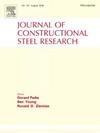Corrosion and mechanical behavior of a new Q450 weathering steel
IF 4
2区 工程技术
Q1 CONSTRUCTION & BUILDING TECHNOLOGY
引用次数: 0
Abstract
Weather-resistant steel represents a significant advancement in addressing corrosion challenges. Several types of steel with enhanced weather resistance have already been developed and manufactured. Weathering steel has shown excellent anti-corrosion ability over conventional structural steel. However, research on the corrosion and mechanical behavior of this type of steel after corrosion damage is still limited. Therefore, this paper conducts a detailed experimental investigation of the corrosion behavior and tensile strength of a new Q450 weathering steel after an accelerated corrosion test. Several scanning techniques were employed to examine the development of corrosion damage in the new Q450 weathering steels after being subjected to different corrosion times. Vickers hardness and velocity intensity of the corroded specimen were obtained to reveal the corrosion behavior of the Q450 steel. Based on the test data, predictive models were developed to predict the pit size and mechanical properties of Q450 steel after corrosion damage. The results suggest that, as the corrosion time increases, the types and amounts of corrosion products change significantly, which causes the passivation film to become much denser. Meanwhile, the mechanical properties are degraded by the increasing corrosion damage. Ultimately, the proposed predictive models are proven to be accurate and reliable.
新型 Q450 耐候钢的腐蚀和机械性能
耐候钢是应对腐蚀挑战的一大进步。目前已开发并生产出多种耐候性更强的钢材。与传统结构钢相比,耐候钢显示出卓越的抗腐蚀能力。然而,对这类钢材在腐蚀破坏后的腐蚀和机械性能的研究仍然有限。因此,本文对新型 Q450 耐候钢加速腐蚀试验后的腐蚀行为和抗拉强度进行了详细的实验研究。本文采用了多种扫描技术来研究新型 Q450 耐候钢在经过不同腐蚀时间后的腐蚀损伤发展情况。获得了腐蚀试样的维氏硬度和速度强度,从而揭示了 Q450 钢的腐蚀行为。根据测试数据,建立了预测模型来预测 Q450 钢腐蚀破坏后的凹坑尺寸和机械性能。结果表明,随着腐蚀时间的延长,腐蚀产物的种类和数量发生了显著变化,导致钝化膜变得更加致密。同时,机械性能也会随着腐蚀损伤的增加而降低。最终,所提出的预测模型被证明是准确可靠的。
本文章由计算机程序翻译,如有差异,请以英文原文为准。
求助全文
约1分钟内获得全文
求助全文
来源期刊

Journal of Constructional Steel Research
工程技术-工程:土木
CiteScore
7.90
自引率
19.50%
发文量
550
审稿时长
46 days
期刊介绍:
The Journal of Constructional Steel Research provides an international forum for the presentation and discussion of the latest developments in structural steel research and their applications. It is aimed not only at researchers but also at those likely to be most affected by research results, i.e. designers and fabricators. Original papers of a high standard dealing with all aspects of steel research including theoretical and experimental research on elements, assemblages, connection and material properties are considered for publication.
 求助内容:
求助内容: 应助结果提醒方式:
应助结果提醒方式:


